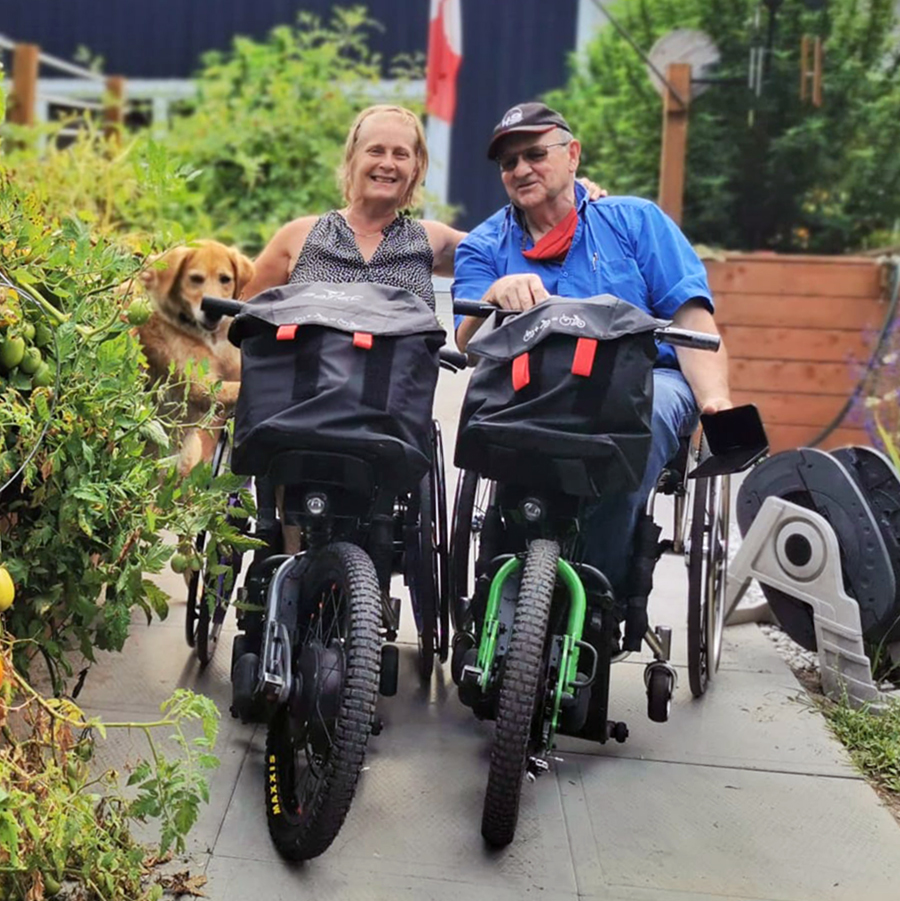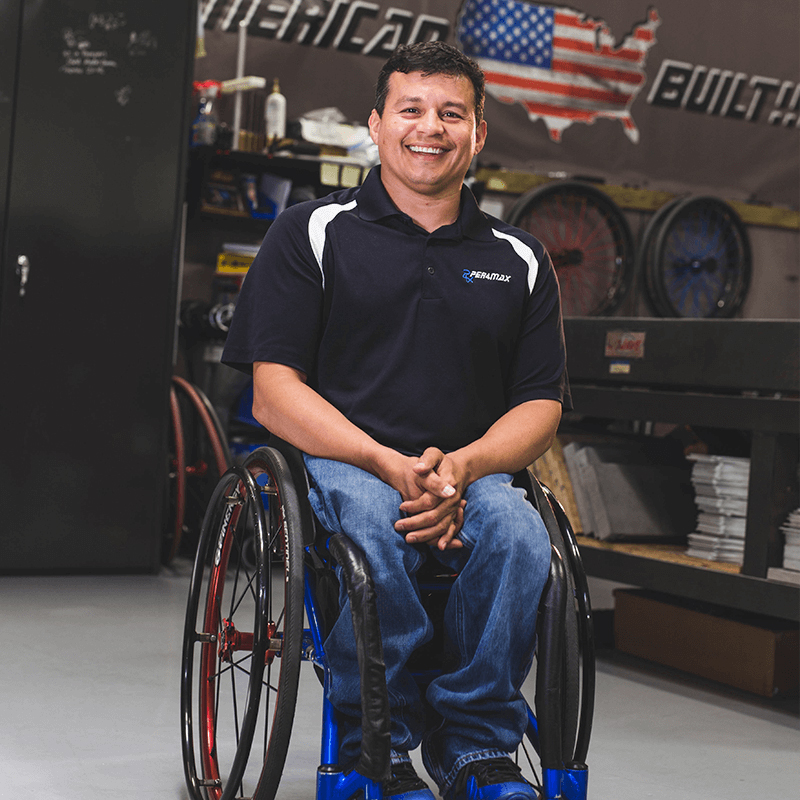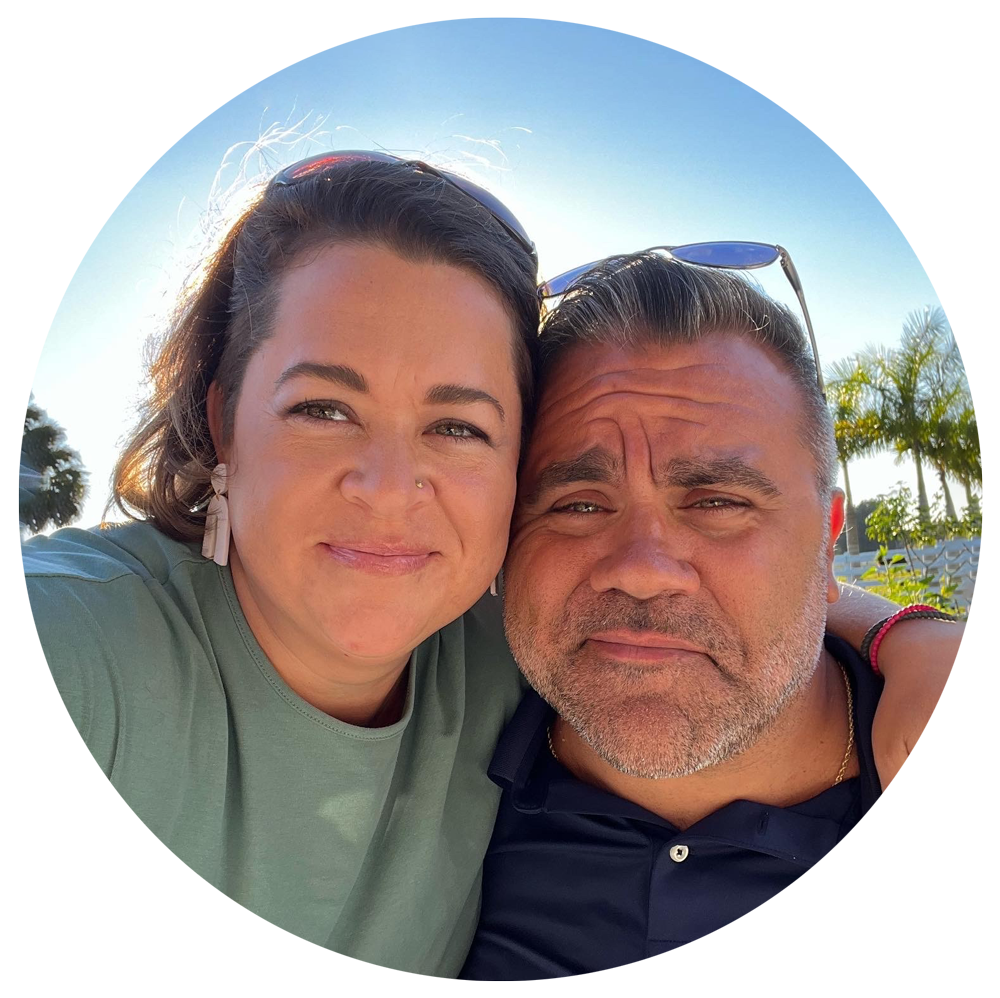Across North America, we found wheelchair users running their own DME businesses that sell everything from recreational equipment to everyday chairs to elite sporting equipment. These dealers use their personal experience and hard-won knowledge to help improve the lives of their customers.
John Squires first connected to the adaptive equipment industry when he became a quadriplegic in a 1987 diving accident. He founded Ohio’s first wheelchair rugby team, competed in numerous handcycle marathons and even met his wife, Annalisa, working in the industry. The two of them spent more than a decade subcontracting with Bike-On.com before deciding to venture out on their own with Rolling in Paradise in 2021.
Their goal: Provide the kind of personalized customer service that has become harder and harder to find in the durable medical equipment industry.
“It used to be you had a choice. You could go down to a ‘Bob and Mary’s DME shop’ whose owners may have had a disabled child, and you felt that they had empathy for you. In the mid-’90s, things started changing because insurance was cutting everything back,” says Squires. “We feel that it’s incredibly important that providers in our community are actually disabled people rather than nondisabled folks just selling very expensive pieces of equipment to our community. And, you know, that’s what we’re finding.”
They’re not the only ones.

Husband and wife Reg McClellan and Chantal Benoit spent a combined 47 years playing on Canada’s national wheelchair basketball team. Today, they run 49 Bespoke, an Ontario-based company that sells custom-fit RGK wheelchairs alongside a variety of everyday mobility products. I purchase from 49 Bespoke for some of my own DME needs.
McClellan’s experience as a wheelchair user lets him challenge norms in the industry, such as the key measurements used to fit a person for a chair. In wheelchair sports, where the wheelchair is often considered an extension of the body, convincing an athlete to get a tight-fitting chair isn’t difficult. 49 Bespoke has a harder time convincing new everyday users of the benefits of a formed fit.
“Right now, people are still being taught to measure outside-inside-outside the thigh and add one to two inches for winter clothing or whatever,” says McClellan. “But we measure outside the thigh to outside the thigh and then see if we can have a rigid side guard to allow an even snugger position.” In addition to reducing the chair’s overall width, McClellan says a snug fit can provide stability similar to what athletes experience when they strap their hips into their sports chairs.
McClellan’s mission to get people into chairs that promote an active lifestyle began in the late 1970s. That’s when he took a trip to California to have Jeff Minnebraker, inventor of the revolutionary Quadra wheelchair, build him an everyday chair. While there, Minnebraker asked if he was interested in being the Canadian distributor for the product. Finding out all he needed to do was buy 50 units helped McClellan make up his mind. “I said, ‘Well, geez, I know quite a few people, so why not?’”
The DME industry has steadily grown over the last 60 years. Grand View Research estimates that the market could reach $271 billion worldwide by 2026. That’s more than the 2021 gross domestic product of Portugal.
The DME industry has steadily grown the last 60 years. Grand View Research estimates that the market could reach $271 billion worldwide by 2026. That’s more than the 2021 gross domestic product of Portugal.
You’d think being the first to bring a solid frame wheelchair to Canada, in the late ’70s no less, would be a risky undertaking. Not so. “It was obviously a product that was due,” McClellan says. “We had 250 of the units sold before the first 50 came in.” Part of this success was the desire of wheelchair users to enjoy active lifestyles. Another factor was the new paint finishes, which set the Quadras apart from older, staler-looking options. The clincher was a simple change from chrome and stainless steel to a powder-coated or anodized finish that reduced the medical stigma attached to everyday chairs.

Like McClellan, William Hernandez’s experience as a wheelchair athlete got him into the DME industry. Hernandez was competing for the University of Texas at Arlington in the mid-’90s when he and three other engineering classmates came up with the idea to design a chair. Hernandez started building basketball wheelchairs and founded PER4MAX, a Texas-based company that now offers sport and everyday wheelchairs.
Hernandez agrees there is no substitute for the personal experience of a wheelchair user who can identify and address problems with the products they sell. In PER4MAX’s case, that can be as simple as looking at the location of the caster housing or rethinking measurements. “You have individuals who are swimming in their chair. And when I say swimming, I mean they [other providers] always give them a chair that has maybe an inch or two of clearance between their side guards and hips.”
Whether it’s building a sport or an everyday wheelchair, Hernandez aims to make a chair that perfectly fits each client, both in terms of bodily measurements and how they move.
The Right Equipment
For the Squires, perfect fit goes beyond measurements to selecting the right type of equipment and options based on a client’s goals, functional abilities and budget. John is blunt about what makes a disabled service provider different from a nondisabled one. “Anybody can spec out a wheelchair for a fit, low [level] paraplegic,” he says. “I mean, let’s face it, those guys, they can pretty much do anything short of walking.”
But, he says, many nondisabled providers have limited knowledge of which types of equipment and adaptations work best for quads and others with more complex disabilities. That lack of knowledge often pigeonholes people into suboptimal equipment, as what works well for one person’s injury level may leave another unable to use the function they do have. Think of a quad with their hands ace-bandaged to a handcycle’s cranks or fighting gravity as they try to push a manual wheelchair with no dump.
John and Annalisa pride themselves on being able to answer disability-specific questions that might stump nondisabled service providers. One area these questions come up most, John says, is when they’re working on active living equipment, like the variety of handcycles that Rolling in Paradise sells.
“I get a lot of people asking me, ‘Well, how do you cath when you’re in the bike? What do you do when you’re out on the long ride? How do you manage that?’ They’re not going to ask Joe, the 6-foot-2 blond-haired ATP that’s trying to sell them a wheelchair. And what’s he going to tell them?”

John and Annalisa identify as an interabled couple, something that Annalisa says helps when the clients and their partners come in to talk about not only purchasing a product but the realities of living with a disability and, in some cases, taking on a care role.
“They feel a little more open to asking me those questions because they know some of the things that I go through from a caregiving standpoint,” says Annalisa. “What about skin? What about their foot placement?” Also, she says, partners who take on a caregiving role tend to have questions about what it takes to get someone into and out of a piece of equipment.
The Squires agree that those discussions between wheelchair users and their partners can shift the equipment that Rolling in Paradise might suggest. Annalisa gives an example: choosing between a handcycle and a device that attaches to a wheelchair.
“For somebody that’s getting into it, that’s new, they look at the handcycle, and they’re like, ‘Wow, it’s so sweet. It’s awesome,’” says John. “It’s this really cool piece of equipment, but it might not be the right fit for that person yet.”
Money Talks
For anyone in the market for mobility equipment, cost is often high on the list of considerations. John Squires says that the varying reimbursement rates provided to sellers by Medicare, Medicaid and private insurers, — numbers that depend on the brand — restrict the options for consumers. That’s a big reason why Rolling in Paradise chose to move away from insurance. They prefer to stay small and provide products that promote an active lifestyle, such as handcycles. It’s something that John says is now a fundamental part of their business. “A lot of the bigger durable medical equipment suppliers, they’re pushing what they make the most margin on, which, most times, is not the best piece of equipment for the person in our community.”
Another frustration John and Annalisa have is the disconnect between the stated mission of health care — to support disabled people in being healthy — and what insurance will approve. It’s a fact that insurance won’t cover many items that can help keep disabled people healthy.
“It’s a shame that insurance companies do not pay for some of this equipment because this equipment … the bikes, the handcycles … those ultimately lead to better mental health, better physical health. This, in turn, should hopefully reduce your chance for illness, hospitalization, sickness,” says Annalisa. “And if they really thought about it, they’d see this would help … but they don’t. It’s all about the dollars, sadly.”
In Canada, McClellan also sees benefit in selling directly to consumers rather than having funding sources and medical providers inserted into the process. The fewer players involved, the more likely the consumer is to ask questions, push back when something doesn’t seem like a good fit, and ultimately, get the right equipment.
Regardless of how you get your mobility equipment, who fits it and who pays for it, McClellan has one final piece of advice gleaned from 40 years in the industry. “People ask me what the best chair is on the market. I keep telling them that there really is only one good chair on the market, and that’s the one that best fits you and does the job for you.”
Support New MobilityWait! Before you wander off to other parts of the internet, please consider supporting New Mobility. For more than three decades, New Mobility has published groundbreaking content for active wheelchair users. We share practical advice from wheelchair users across the country, review life-changing technology and demand equity in healthcare, travel and all facets of life. But none of this is cheap, easy or profitable. Your support helps us give wheelchair users the resources to build a fulfilling life. |


Recent Comments
Bill on LapStacker Relaunches Wheelchair Carrying System
Phillip Gossett on Functional Fitness: How To Make Your Transfers Easier
Kevin Hoy on TiLite Releases Its First Carbon Fiber Wheelchair